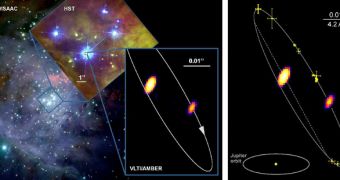Peering deep inside the Orion nebula, the Very Large Telescope Interferometer (VLTI) at the European Southern Observatory's (ESO) Chile facility has discovered that the long-known Theta 1 Orionis C pair of stars is, in fact, a binary system. Its two members are locked in the same orbit around each other, and this fact could only be established after interferometry was used. The new technique allows physicists to combine images from telescopes located miles apart, and to process them into pictures that look like they have been taken by a telescope with a gigantic lens.
The T1OC is one of the brightest star systems in the highly active Trapezium Cluster. However, it's binary nature has remained a mystery to experts thus far. And it would stand to reason that it couldn't have been discovered until now. For the new research, the VLTI has behaved like a telescope with a 426-foot (130-meter) main mirror, Space reports.
For comparison, consider that Hubble only has a 7.8-foot (2.4-meter) mirror. “Our observations demonstrate the fascinating new imaging capabilities of the VLTI. This infrared interferometry technique will certainly lead to many fundamental new discoveries,” Max Planck Institute for Radio Astronomy expert Gerd Weigelt, who has also been a co-investigator for the new find, said.
The relatively high-resolution photo spans 2 milliarcseconds. When talking about space-related pictures, it's difficult to apply the concept of hi-res, on account of the fact that some of the targets for the cameras are located trillions of miles away, in very distant galaxies. The T1OC formation is relatively close to Earth, just some 1,350 light-years (12.75 trillion kilometers) away.
Weigelt and colleague Stefan Kraus have also found another amazing feat of the system – the stars revolve around each other in an 11-year cycle, roughly similar to that of our own Sun. The two celestial bodies are not even in mass and size: while the first one is 11 times more massive than our Sun, the other is 38 times its size. The experts hope that the data collected with the new images will help them get a better insight into how stars are exactly formed in the Orion nebula.

 14 DAY TRIAL //
14 DAY TRIAL //